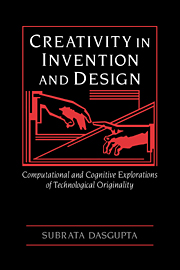Book contents
- Frontmatter
- Contents
- Preface
- Acknowledgments
- Part I Creativity in invention and design: issues and ingredients
- 1 Creativity, invention, and the computational metaphor
- 2 A computational theory of scientific creativity
- 3 Maurice Wilkes and the origins of microprogramming: the historical setting
- Part II The invention of microprogramming: a cognitive explanation
- Part III Reflections on the nature of inventing
- Appendix
- References
- Index
2 - A computational theory of scientific creativity
Published online by Cambridge University Press: 23 December 2009
- Frontmatter
- Contents
- Preface
- Acknowledgments
- Part I Creativity in invention and design: issues and ingredients
- 1 Creativity, invention, and the computational metaphor
- 2 A computational theory of scientific creativity
- 3 Maurice Wilkes and the origins of microprogramming: the historical setting
- Part II The invention of microprogramming: a cognitive explanation
- Part III Reflections on the nature of inventing
- Appendix
- References
- Index
Summary
Recall from the past chapter (specifically, the section “Computation as metaphor for the exploration of creativity”) that what has been named the computational theory of scientific creativity or CTSC is a hypothesis about the nature of creativity (in the natural and the artificial sciences). This hypothesis is, furthermore, firmly rooted in the computational metaphor – more precisely, it relies on the formation of a metaphorical model connecting creative and computational processes.
It also bears repeating that this theory goes back to Newell, Shaw, and Simon (1962) and, in effect, is a special case of a broader theory of thinking known concisely as the physical symbol system hypothesis (Newell and Simon 1976). The theory also serves as the basis for some recent explanations, by Kulkarni and Simon (1988), Thagard and Nowak (1990), and Thagard (1988, 1990), of certain historically important discoveries in the natural sciences. Thus, the general nature of CTSC is well known and has been so for some time. The task of the present chapter is to articulate and state CTSC in a sufficiently precise form such that (1) the reader understands and can anticipate, at least in general terms, the direction along which the explanation of Wilkes's creativity will proceed in the chapters to follow (especially, in Chapters 4–6) and (2) it is posed as a genuinely testable (i.e., in principle, falsifiable) hypothesis for which the Wilkes case study constitutes a nontrivial test. The extent to which CTSC is, in fact, corroborated or refuted by this test, and the general lessons learned from the case study, are matters discussed in the final part of this book.
- Type
- Chapter
- Information
- Creativity in Invention and Design , pp. 51 - 64Publisher: Cambridge University PressPrint publication year: 1994



